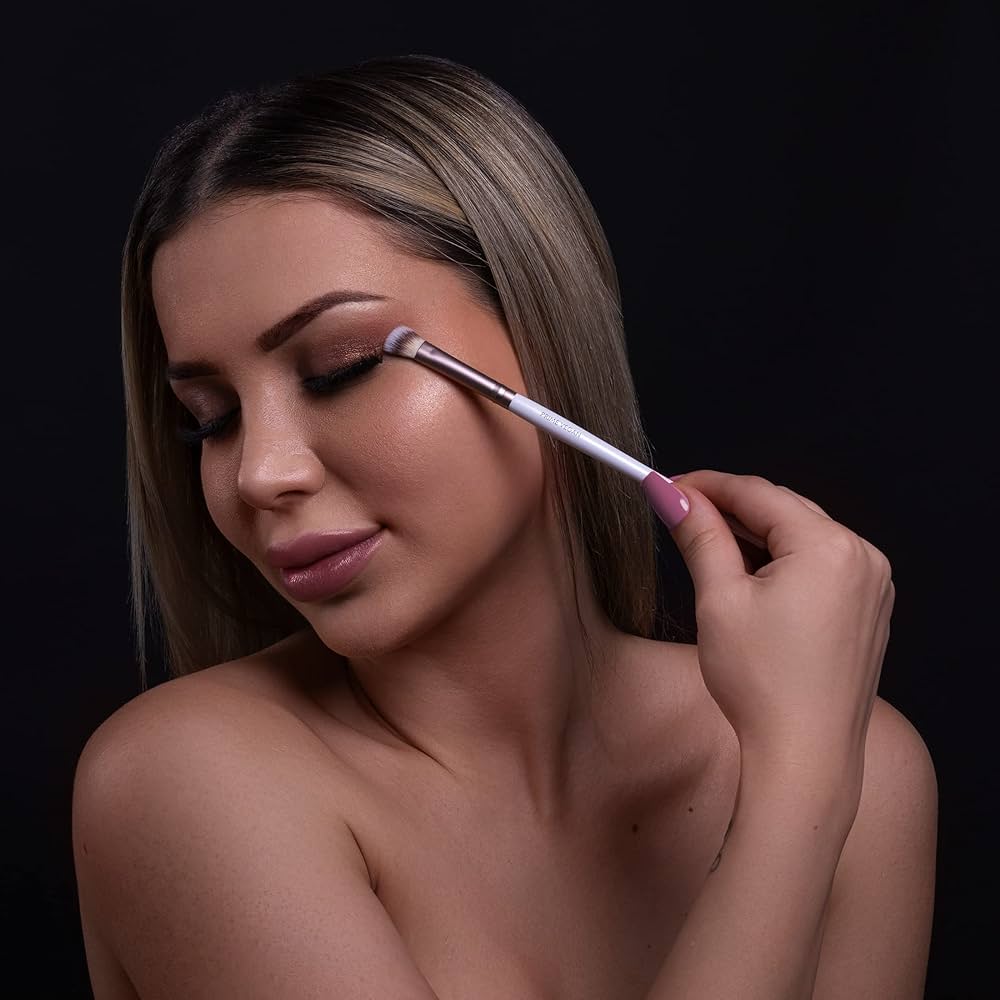
Maintain Your Foundation Brush: Easy Cleaning Tips
Why Regular Brush Cleaning Matters
Maintaining clean makeup brushes, especially foundation brushes, is crucial for achieving flawless makeup application and maintaining skin health. Foundation brushes, in particular, require frequent cleaning due to their regular contact with liquid or cream products. These brushes can quickly accumulate product residue, oils, dead skin cells, and bacteria. Using a dirty foundation brush not only affects the quality of makeup application but also poses risks to skin health.How to clean foundation brush? Dirty brushes can lead to clogged pores, breakouts, and even skin infections.
Regular cleaning ensures that the brush maintains its softness and shape, prolonging its lifespan. Additionally, clean brushes blend foundation more smoothly and evenly, resulting in a more professional-looking finish. By establishing a consistent cleaning routine, makeup enthusiasts can protect their skin, extend the life of their brushes, and enhance their overall makeup application experience. Moreover, clean brushes prevent the transfer of old, oxidized foundation onto the skin, ensuring a fresh and hygienic application every time.

Determining the Right Cleaning Frequency
The frequency of cleaning foundation brushes depends on various factors, including usage and skin type. How to clean foundation brush? For individuals who apply foundation daily, cleaning the brush at least once a week is recommended. Those with oily or acne-prone skin may benefit from cleaning their brushes more frequently, possibly every 3-4 days. Professional makeup artists should clean their brushes after each client to maintain hygiene standards. However, even for personal use, a quick clean after each application can help maintain brush cleanliness between deep cleanings. Factors like climate and storage conditions also influence cleaning frequency.
In humid environments, brushes may require more frequent cleaning to prevent mold growth. Additionally, the type of foundation used affects cleaning needs. Liquid foundations tend to build up more quickly than powder foundations, necessitating more frequent cleaning. By assessing these factors, users can establish a cleaning routine that balances brush maintenance with practical considerations. Regular cleaning not only maintains brush quality but also ensures consistent makeup application results.
Gathering the Necessary Cleaning Supplies
Before beginning the cleaning process, gathering the right supplies ensures effective and safe brush cleaning.How to clean foundation brush? Essential items include a gentle, unscented soap or specialized brush cleanser, lukewarm water, a clean towel, and a flat surface for drying. Mild baby shampoo or facial cleansers work well as they effectively remove makeup without damaging brush bristles. For a more eco-friendly option, consider using castile soap or a DIY brush cleaner made from gentle ingredients.
A textured cleaning mat or silicone cleaning glove can help in thoroughly cleansing the bristles. A wide, shallow bowl or sink will be needed to hold water for rinsing. Paper towels or a lint-free cloth are useful for gently blotting excess water from the brush after washing. For those who prefer a more specialized approach, brush cleaning sprays and solid cleansers are available in the market. Having all these supplies ready beforehand streamlines the cleaning process and ensures that the brush receives thorough and proper care.

The Step-by-Step Cleaning Process
How to clean foundation brush? Cleaning a foundation brush effectively involves a series of simple yet crucial steps. Begin by wetting the brush bristles with lukewarm water, ensuring the water flows downward towards the bristle tips to prevent water from entering the ferrule (the metal part holding the bristles). Next, place a small amount of gentle soap or brush cleanser in the palm of your hand or on a cleaning mat. Gently swirl the brush in the cleanser, working it into a lather. Use your fingers or a textured surface to work the soap through the bristles, paying special attention to the center where product buildup is most common.
Rinse the brush thoroughly under running water, again keeping the bristles pointed downward. Continue rinsing until the water runs clear and no soap remains. Gently squeeze out excess water from the bristles, being careful not to pull or twist them. Reshape the brush head to its original form. Finally, lay the brush flat on a clean towel to dry, with the bristles hanging over the edge of a counter to ensure proper air circulation. This process effectively removes product residue, oils, and bacteria from the brush, restoring it to a clean and hygienic state.
Deep Cleaning Techniques for Stubborn Residue
Sometimes, foundation brushes require more intensive cleaning to remove stubborn product buildup. For these situations, deep cleaning techniques can be employed. One effective method involves using olive oil or coconut oil as a pre-treatment. Gently massage a small amount of oil into the bristles to break down stubborn makeup residue. After the oil treatment, proceed with the regular cleaning process using soap and water. Another technique is to soak the brush bristles in a mixture of warm water and gentle shampoo for about 10 minutes before cleaning.
This helps to loosen any hardened product. For extremely soiled brushes, a vinegar solution (one part white vinegar to two parts water) can be used as a disinfecting soak before the regular cleaning process. Always follow these deep cleaning methods with thorough rinsing and proper drying. Some makeup enthusiasts use a brush egg or textured glove to provide extra friction during cleaning, which can be particularly effective for removing tough residue. While these deep cleaning methods are effective, they should be used sparingly to avoid excessive wear on the brush bristles.

Drying and Reshaping Your Brushes
Proper drying and reshaping are crucial steps in maintaining the quality and longevity of foundation brushes. After cleaning, gently squeeze out excess water from the bristles using a clean towel or paper towel. Avoid wringing or twisting the bristles, as this can cause damage and alter the brush’s shape. Reshape the brush head with your fingers, ensuring it retains its original form. For optimal drying, lay the brush flat on a clean towel with the bristles hanging over the edge of a counter or table. This position allows air to circulate around the entire brush, preventing water from seeping into the ferrule, which can loosen the glue holding the bristles.
Alternatively, use a brush drying rack that holds brushes upside down, ensuring complete water drainage. Avoid standing brushes upright to dry, as this can cause water to run into the handle, potentially damaging the brush. Drying time varies depending on brush size and bristle density, but generally takes 6-8 hours. Ensure brushes are completely dry before using or storing them to prevent bacterial growth. Proper drying techniques maintain the brush’s shape and extend its lifespan, ensuring optimal performance in future makeup applications.
Natural vs. Synthetic Brushes: Cleaning Considerations
The cleaning process may vary slightly depending on whether the foundation brush has natural or synthetic bristles. Natural bristles, typically made from animal hair, are more delicate and require gentler cleaning methods. These brushes benefit from using mild, sulfate-free shampoos or specialized brush cleansers. Natural bristles can become dry and brittle, so occasional conditioning with a small amount of hair conditioner can help maintain their softness. Synthetic brushes, made from man-made fibers, are generally more durable and can withstand slightly more rigorous cleaning.
They are less likely to absorb excess water or product, making them easier to clean and quicker to dry. Synthetic brushes can be cleaned with a wider range of products, including regular soap or facial cleansers. However, regardless of bristle type, avoid using hot water or harsh chemicals, as these can damage the bristles and affect the brush’s performance. Understanding the differences between natural and synthetic brushes allows for tailored cleaning approaches, ensuring optimal care and longevity for each brush type.
Quick Cleaning Methods for Daily Maintenance
While deep cleaning is essential, daily maintenance can help keep foundation brushes in good condition between thorough washes. How to clean foundation brush? Quick cleaning methods are particularly useful for makeup artists or those who apply foundation daily. One effective method is using a brush cleansing spray. Simply spray the product onto the bristles and gently wipe the brush on a clean tissue or cloth until no more product comes off. Another quick technique involves using a brush cleaning wipe or a makeup removing wipe to gently clean the bristles after each use.
For a DIY approach, a mixture of witch hazel and a drop of mild soap on a paper towel can effectively remove product buildup. These quick cleaning methods help remove surface-level product and oils, reducing the frequency of deep cleaning needed. However, it’s important to note that these methods do not replace regular deep cleaning. They serve as interim measures to maintain brush hygiene and performance between more thorough cleanings. Incorporating these quick cleaning techniques into a daily routine can significantly improve brush hygiene and makeup application quality.

Storing Brushes to Maintain Cleanliness
Proper storage of foundation brushes is crucial in maintaining their cleanliness and shape between uses and cleanings. How to clean foundation brush? Store brushes in a cool, dry place away from direct sunlight and humidity. Avoid storing brushes in airtight containers or bags, as this can trap moisture and promote bacterial growth. Instead, use a brush holder or cup that allows air circulation around the bristles. Store brushes with the bristles facing upward to prevent them from bending or becoming misshapen.
For travel or professional kits, use brush guards or rolls to protect the bristles from damage and contamination. Consider using a brush tree or stand that holds brushes upside down, allowing any residual moisture to drain away from the ferrule. Keep brushes separate from other makeup products to prevent cross-contamination. Regularly clean and disinfect the storage area to maintain a hygienic environment for the brushes. By implementing proper storage techniques, users can extend the life of their brushes and ensure they remain clean and ready for use. Good storage habits complement regular cleaning routines, contributing to overall brush health and performance.
Recognizing When to Replace Your Foundation Brush
Even with proper care and cleaning, foundation brushes eventually need replacement. Recognizing the signs of a worn-out brush is crucial for maintaining makeup application quality and skin health. One clear indicator is persistent shedding of bristles, even after cleaning. If the brush shape becomes permanently distorted or the bristles remain splayed after washing and reshaping, it’s time for a replacement. Discoloration that doesn’t improve with cleaning can indicate deep-set product buildup or bacterial growth.
Brushes that develop a persistent odor, despite thorough cleaning, should be discarded. Additionally, if the bristles feel rough or scratchy on the skin, the brush has likely reached the end of its lifespan. For synthetic brushes, signs of melting or clumping of bristles indicate heat damage and necessitate replacement. Natural hair brushes that become excessively dry or brittle, even with conditioning, should be retired. Generally, with proper care, a high-quality foundation brush can last anywhere from 1 to 3 years. However, frequency of use, quality of the brush, and maintenance habits can affect this timeframe. Regularly assessing brush condition ensures that makeup tools remain effective and hygienic.

